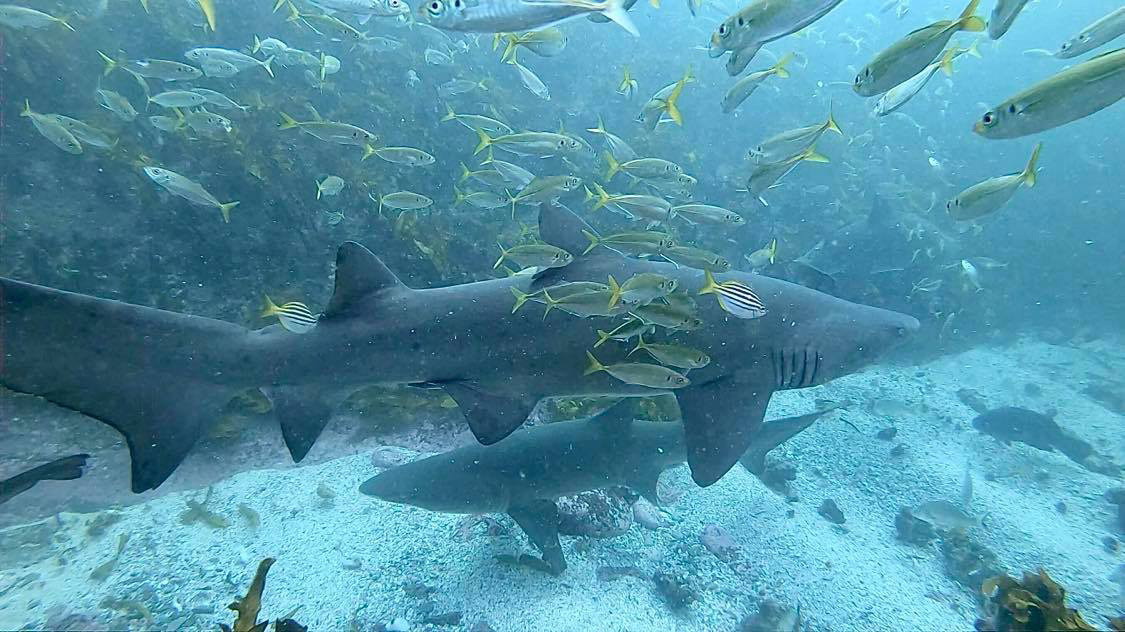Grey nurse shark (Carcharias taurus)
The Grey Nurse Shark was the first protected shark in the world when it was listed under NSW legislation in 1984!
Grey Nurse Sharks have large stout bodies, a pointed snout
with many rows of visible teeth and small eyes. They are
grey to grey-brown on top, paler underneath and sometimes
have reddish or brownish spots on their backs. Despite their
appearance, Grey Nurse Sharks are not a threat to divers or
swimmers and actually have a very placid nature.
The sharks have two large dorsal fins of similar size. The tail
is distinctive as the top lobe is larger than the bottom. Their
upper body is bronze-coloured, while the underside is paler.
Juveniles tend to have darker spots on the lower half of their
body which fade as they get older.
The breeding of Grey Nurse Sharks is quite unusual. Mating occurs mainly in autumn and is followed by a 9 - 12 month gestation period, and the young are born in winter. Towards the end of the gestation period, the more fully developed embryos eat the less developed embryos and unfertilised eggs within the female shark’s uterus. As a result, only two pups are produced per litter – one in each uterus. Grey Nurse Sharks tend to breed only once every two years. This is the lowest reproductive rate of any shark and makes it more susceptible to external pressures that increase mortality.
What is threatening them?
Grey Nurse Sharks have suffered a decline over recent years, resulting in the listing of the east coast population as ‘critically endangered’. A New South Wales Fisheries survey in 2000 revealed that the number of Grey Nurse Sharks in New South Wales could be as low as 292 individuals. Although the sharks are protected today, they were commercially fished quite extensively in the past. Illegal fishing still occurs, and accidental capture by both commercial and recreational fishers also poses a serious threat.
In the 1950s and 1960s, the misconception that Grey Nurse Sharks were ‘man-eaters’ led to intensive fishing efforts by spearfishers using explosive headed spears. The sharks’ placid nature made them easy targets. Beach safety nets, designed to keep out sharks that are dangerous to humans, can also trap the harmless Grey Nurse Shark.
How you can help?
• Remove any rubbish or fishing gear that you see in the water or on the beach
• Refrain from fishing in Grey Nurse Shark areas
• If diving, upload any photo on https://www.spotashark.com/ to help identify individual Grey Nurse sharks and track shark movement
• If fishing, report any Grey Nurse Sharks accidentally caught to New South Wales Fisheries
• Contact the Threatened Species Network in your state and participate in volunteer work
• Learn more about threatened species and their habitats (to know more abour Grey Nurse sharks Click Here)
• Enroll in AWARE Shark Conservation Specialty Course
Diving with Grey Nurse sharks
In order to protect Grey Nurse sharks and their habitat, the following Code of Conduct has been set forth by
Department of Primary Industries.
To comply with the Code of Conduct for Diving with Greynurse Sharks all divers must not:
- Night dive in sites identified as habitat critical to the survival of Greynurse Sharks;
- Touch, feed or interfere with the natural behaviour of Greynurse
Sharks; » Chase, harass or interrupt the swimming patterns of Greynurse
Sharks.
- Block cave entrances, gutters or entrap Greynurse Sharks;
- Dive in groups totalling more than ten divers; and
- Use mechanical apparatus including but not limited to scooters and horns or electronic shark protection devices.
In Forster, only one dive site, The Pinnacle is classified as Critical habitat for the GNS. As well as Big and Little Seal Rock down the road. However at Forster Dive Centre, we ask our divers to adopt this Code of Conduct for every dive site where Grey Nurse sharks can be found such as Hayden's Rock or Latitude Rock.
